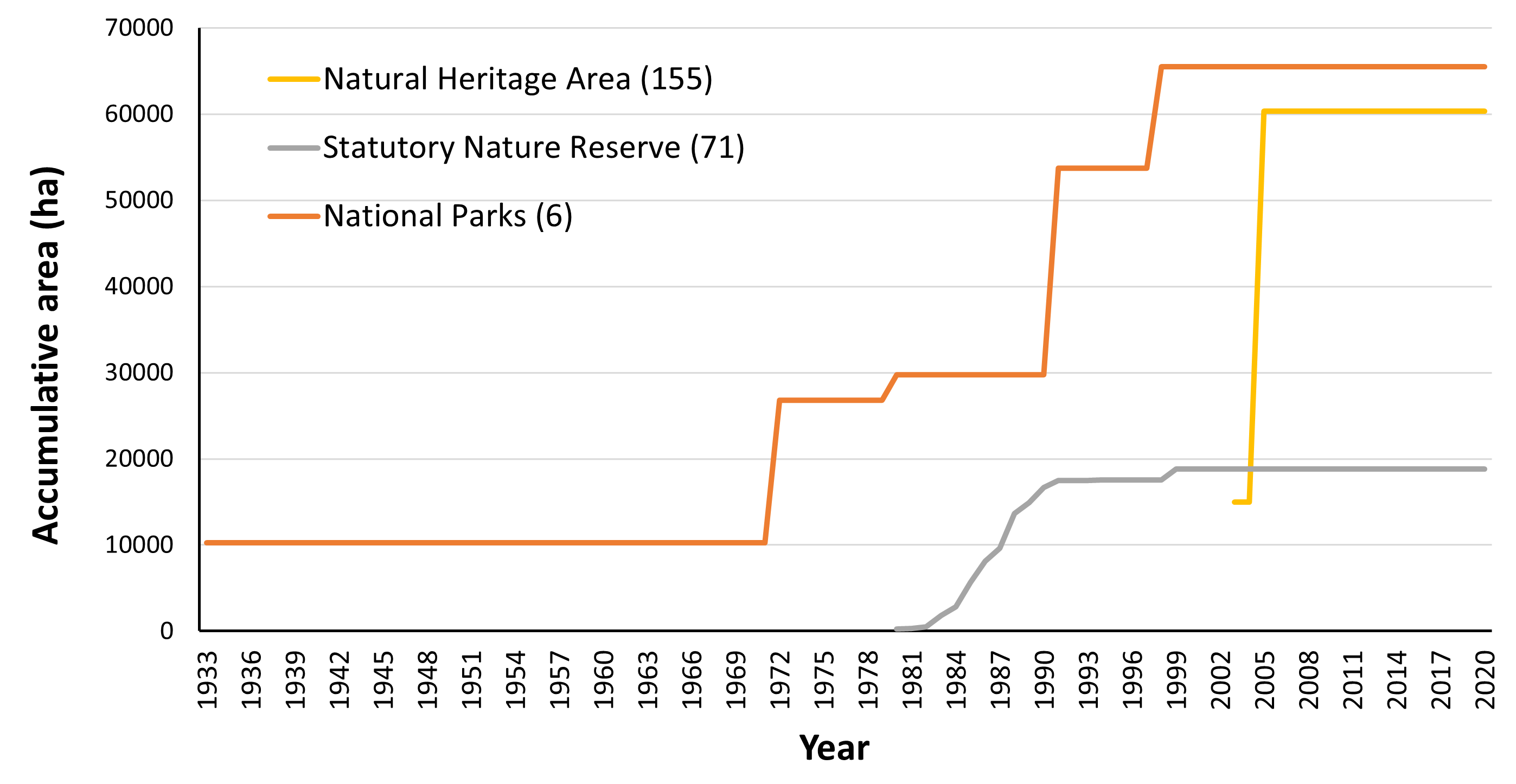| Current status | 2020 |  |
| Short term status | 2011 - 2020 |  |
| Long term status | 2001 - 2020 |  |
Click on the charts below in order to see the full resolution versions.
The basic designation for wildlife in Ireland is the Natural Heritage Area (NHA). This is an area considered important for the habitats present or which holds species of plants and animals whose habitat needs protection. After European designated protected areas in Ireland, NHAs represent the largest nationally designated protected areas with 155 sites covering 60,326 ha. Under the Wildlife Amendment Act (2000), NHAs are legally protected from damage from the date they are formally proposed for designation.
At present, NHAs largely represent raised and blanket bog habitats but there are an additional 1090 proposed NHAs (pNHAs) covering 845,223 ha which were published on a non-statutory basis in 1995 that represent a diversity of sites deserving protection, from small roost areas for rare bats to large lakes and woodlands. Prior to statutory designation, pNHAs are subject to limited protection, in the form of: agri-environmental farm planning schemes that continue to support the objective of maintaining and enhancing the conservation status of pNHAs; the Forest Service requirement for National Parks and Wildlife Service approval before they will pay afforestation grants on pNHA lands; and recognition of the ecological value of pNHAs by Planning and Licencing Authorities.
Statutory Nature Reserves are areas important to wildlife that has received protection under Ministerial Order via the Wildlife Act (1976) and Wildlife Amendment Act (2000). The majority are owned by the state, but some are also owned by organisations or private landowners. With 71 sites covering 18,815 ha, Statutory Nature Reserves are a relatively small network of protected areas only in existence since 1980 but are regarded as the most rigorous national designation for the protection of habitats and species. All Statutory Nature Reserves now lie within a Natural Heritage Area or proposed Natural Heritage Area.
National Parks are areas designated with the twin objectives of protecting habitats and species and providing a public amenity area for the appreciation of nature. In 1969, the International Union for the Conservation of Nature (IUCN) recommended that all governments agree to reserve the term 'National Park' to areas to uphold these objectives in addition to preventing or eliminating the exploitation and occupation of the area bounded by the park, and the implementation of effective management to maintain the natural feature which led to its establishment. Ireland’s six national parks, namely Ballycroy, Burren, Connemara, Glenveagh, Killarney and Wicklow Mountains National Parks cover an area of 65,447 ha. Of the six the oldest, Killarney National Park, being established in 1933 is also the only national park with legislative backing (Bourn Vincent Memorial Act 1936 and subsequent Environment (Miscellaneous Provisions) Act 2015). However, all National Parks encompass multiple designated protected areas that do have a statutory basis.
There two other designations with legal backing under the Wildlife Acts (1976, 2000): Refuge for Fauna and Wildfowl Sanctuary. To date, seven Refuge for Fauna are exclusively focussed on the protection of birds on cliffs and islands. Refuge for Fauna can be designated protected areas for named species of wild animal and effectively operate as a compulsory management agreement for which compensation is provided. Ireland 68 Wildfowl Sanctuaries protect certain ducks, geese and waders from hunting at specific times of the year, but do not confer protection on their habitats. Many of the Wildfowl Sanctuaries now lie within European designated Special Protection Areas giving some measure of protection.
Other than designations specifically targeting areas for nature protection there are other amenity designations implemented by Local Authorities that facilitate wildlife protection. Areas of Special Control in Development Plans are areas zoned by Local Authorities in their development plans e.g. Area of High Amenity Value, where stricter planning controls apply within scenic landscapes. The exact area covered by this designation is potentially extensive but currently not available and is fluid across Local Authorities and over time across development plans. It also has no statutory basis, but indirectly enforced by Local Authorities through development plans provided for by the Local Government (Planning and Development) Acts and Regulations. For specific areas, Local Authorities can also designate Special Amenity Area Orders (SAAO) to protect outstanding landscapes and amenities by strictly controlling development without the need for compensation. Their statutory basis is by Ministerial Order under the Local Government (Planning and Development) Acts, but to date only three SAAOs exist, and all are in Co. Dublin (North Bull Island, Liffey Valley and Howth Head).
Finally, Local Authorities can designate Tree Preservation Orders (TPOs) to protect individual trees, groups of trees or woodlands under the Local Government (Planning and Development) Acts and Regulations. Any trees which are subject to a TPO cannot be felled unless the owner applies for planning permission to their Local Authority. In 1995, there were 178 TPOs in force but several Local Authorities have subsequently used SAAOs as an alternative mechanism to protect trees. Due to the inconsistency in reporting TPOs in Local Authority development plans, the current number of TPOs in force nationally is at present unavailable.
The Convention on Biological Diversity Aichi Biodiversity Target 11 stated that by 2020, all parties should have at least 17% of terrestrial and inland water areas and 10% of coastal and marine areas conserved through “effectively and equitably managed, ecologically representative and well-connected systems of protected areas and other effective area-based conservation measures and integrated into the wider landscape and seascape.” At present, NHAs in combination with spatially non-overlapping internationally designated protected areas (see D1ii) result in 16.8% of terrestrial and inland water areas and 1.32% of marine and coastal areas now lie within designated protected areas.
For more information on nationally designated protected areas: https://www.npws.ie/protected-sites
Reference:
Hickie, D. (1997). Evaluation of Environmental Designations in Ireland. 2nd Edition. The Heritage Council, Kilkenny.

